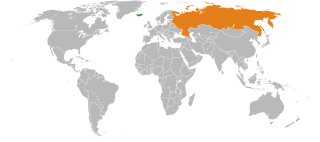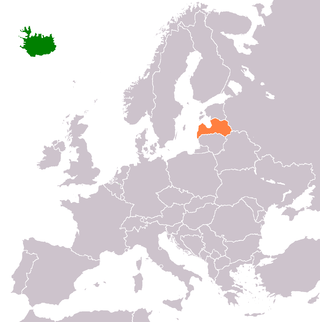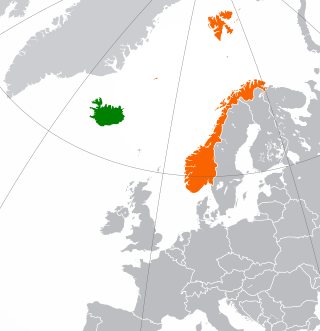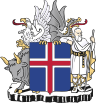Iceland took control of its foreign affairs in 1918 when it became a sovereign country, the Kingdom of Iceland, in a personal union with the King of Denmark. As a fully independent state, Iceland could have joined the League of Nations in 1920, but chose not to do so for cost reasons. It negotiated with Denmark to initially carry out most of its foreign relations, while maintaining full control. Denmark appointed a diplomatic envoy (Ambassador) to Iceland in 1919 and Iceland reciprocated in 1920, opening an Embassy in Copenhagen. Iceland established its own Foreign Service in April 1940 when Denmark became occupied by Nazi Germany and ties between the two countries were severed. The Republic of Iceland was founded in 1944. The Icelandic foreign service grew slowly in the post-WWII period, but increased rapidly after the mid-1990s. Iceland's closest relations are with the Nordic states, the European Union and the United States. Iceland has been a member of the United Nations since 1946. Iceland was a founding member of the World Bank in 1946 and NATO in 1949. In terms of European integration, Iceland was a founding member of the OEEC in 1948 and the Nordic Council in 1952, it joined EFTA in 1970, was a founding member of the CSCE in 1973 and the EEA in 1992 and joined Schengen in 1996.

The anti-NATO riot in Iceland of 30 March 1949 was prompted by the decision of the Alþingi, the Icelandic parliament, to join the newly formed NATO, thereby involving Iceland directly in the Cold War, opposing the Soviet Union and re-militarizing the country.

In July 2001, President Abdelaziz Bouteflika became the first Algerian President to visit the White House since 1985. This visit, followed by a second meeting in November 2001, and President Bouteflika's participation at the June 2004 G8 Sea Island Summit, is indicative of the growing relationship between the United States and Algeria. Since the September 11 attacks in the United States, contacts in key areas of mutual concern, including law enforcement and counter-terrorism cooperation, have intensified. Algeria publicly condemned the terrorist attacks on the United States and has been strongly supportive of the Global War on Terrorism. The United States and Algeria consult closely on key international and regional issues. The pace and scope of senior-level visits has accelerated.

Diplomatic relations between Denmark and the United States of America began in 1783. Both countries are members of the Arctic Council, OECD, OSCE, NATO and the United Nations.

Finland and the United States currently have good relations. The United States recognized Finland on May 7, 1919 after it declared independence in 1917, and officially established diplomatic relations in 1920. Due to World War II and Soviet pressure, relations were suspended between 1942 and 1945 before being raised to embassy level in 1954. Finland has been of strategic importance to the United States due to its position bordering the Soviet Union and later Russia, and after the end of the Cold War in 1991 Finland's shift to the West has led to warmer relations. There is significant trade activity, including military procurement, between the two countries.

Australia–Mexico relations are the bilateral relations between the Commonwealth of Australia and the United Mexican States. Both nations are members of the Asia-Pacific Economic Cooperation, Comprehensive and Progressive Agreement for Trans-Pacific Partnership, G20, MIKTA, Organisation for Economic Co-operation and Development and the World Trade Organization.

Iceland–Russia relations are the relations between the two countries, Iceland and Russia. Russia has an embassy in Reykjavík. Iceland has an embassy in Moscow, and two honorary consulates in Murmansk and Saint Petersburg. Relations between Iceland and Russia have floundered in recent years due to the Russian invasion of Ukraine and the poisoning of Sergei Skripal, and on June 9, 2023, Iceland announced it would be suspending operations at its embassy in Moscow.

Icelandic–British relations are foreign relations between Iceland and the United Kingdom.

Iceland–India relations are the bilateral relations between Iceland and India. Historically, these relations have been friendly but lacked substantive content. Iceland and India established diplomatic relations in 1972. At that time the embassy of Iceland in London, United Kingdom was accredited to India and the embassy of India in Oslo, Norway, was accredited to Iceland. Embassies were established in New Delhi in 2005 and in Reykjavík in 2006.

The nations of Brazil and Mexico established diplomatic relations in 1825. Together, Brazil and Mexico account as the most populous nations in Latin America and both nations have the largest global emerging economies and are considered to be regional powers. Both countries are members of the Community of Latin American and Caribbean States, G-20 major economies, Latin American Integration Association, Organization of American States, Organization of Ibero-American States and the United Nations.

The nations of Israel and Mexico established diplomatic relations in 1952. Both nations are members of the Organisation for Economic Co-operation and Development, the United Nations and the World Trade Organization.

The current and historical relations between the Argentine Republic and the Portuguese Republic, have existed for over a century. Both nations are members of the Organization of Ibero-American States and the United Nations.

Iceland–Latvia relations are foreign relations between Iceland and Latvia. Iceland was the first country to recognize the independence of Latvia in August 1991. Both countries re-established diplomatic relations on August 22, 1991. Neither country has a resident ambassador. Iceland is represented in Latvia through its embassy in Helsinki (Finland). Latvia is represented in Iceland through its embassy in Oslo (Norway) and an honorary consulate in Reykjavík.

Iceland–Mexico relations are the bilateral relations between Iceland and the United Mexican States. Both nations are mutual members of the Organisation for Economic Co-operation and Development, United Nations and the World Trade Organization.

Iceland–Norway relations are foreign relations between Iceland and Norway. Iceland has an embassy in Oslo and Norway has an embassy in Reykjavík.

Canada and Iceland have longstanding foreign relations. Contact goes back over a thousand years, but formal diplomatic relations began in 1947. Both nations are members of the Arctic Council, NATO, OECD, and WTO. Additionally, Canada holds observer status in the BEAC.

Throughout the Cold War, the nation of Iceland was a member of the North Atlantic Treaty Organization (NATO) and allied with the United States, hosting a US military presence in Keflavík Air Base from 1951 to 2006.

The nations of the Dominican Republic and Mexico established diplomatic relations in 1890. Both nations have over the years joined several multilateral forums and are members of the Association of Caribbean States, Community of Latin American and Caribbean States, Organization of American States, Organization of Ibero-American States and the United Nations.

The Helsinki Summit was a private, bilateral meeting between American President George H. W. Bush and Soviet President Mikhail Gorbachev that took place in Helsinki, Finland on September 9, 1990. Due to the vested interests of both the Soviet Union and the United States in the Gulf Crisis' resolution, August 1990 Iraqi invasion of Kuwait was the primary topic of discussion for the leaders during the Helsinki Summit. The concerted efforts at easing American-Soviet tensions in the aftermath of the Cold War was another prominent topic, among other notable current events. At the summit's conclusion, Presidents Bush and Gorbachev produced a document of joint statements that illuminated the areas in which the leaders had committed to aligning their foreign policy goals. The summit was followed by a press conference wherein members of the media questioned Presidents Bush and Gorbachev about the content of their meeting and the justifications for their joint statements.

Norway–Poland relations are the diplomatic relations between the Kingdom of Norway and the Republic of Poland. Both nations enjoy friendly relations, the importance of which centers on mutual historical relations and the fact that more than 100,000 Polish citizens live in Norway on a permanent basis, Poles make up 2.10% of the Norwegian population. Both nations are members of the Council of Europe, Council of the Baltic Sea States, NATO, OECD, OSCE, United Nations and the World Trade Organization.























